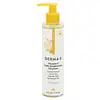What's inside
What's inside
 Key Ingredients
Key Ingredients

 Benefits
Benefits

 Concerns
Concerns

 Ingredients Side-by-side
Ingredients Side-by-side

Water
Skin ConditioningSodium Methyl Cocoyl Taurate
CleansingCocamidopropyl Hydroxysultaine
CleansingGlyceryl Laurate
EmollientDisodium Laureth Sulfosuccinate
CleansingCocamidopropyl Betaine
CleansingNiacinamide
SmoothingPanthenol
Skin ConditioningGlycolic Acid
BufferingGlycyrrhiza Glabra Root Extract
BleachingAscorbyl Palmitate
AntioxidantArctostaphylos Uva Ursi Leaf Extract
Skin ConditioningLilium Candidum Leaf Cell Extract
Skin ConditioningCamellia Sinensis Leaf Extract
AntimicrobialRetinyl Palmitate
Skin ConditioningAllantoin
Skin ConditioningCitrus Aurantium Dulcis Oil
MaskingPotassium Sorbate
PreservativePhenoxyethanol
PreservativeEthylhexylglycerin
Skin ConditioningWater, Sodium Methyl Cocoyl Taurate, Cocamidopropyl Hydroxysultaine, Glyceryl Laurate, Disodium Laureth Sulfosuccinate, Cocamidopropyl Betaine, Niacinamide, Panthenol, Glycolic Acid, Glycyrrhiza Glabra Root Extract, Ascorbyl Palmitate, Arctostaphylos Uva Ursi Leaf Extract, Lilium Candidum Leaf Cell Extract, Camellia Sinensis Leaf Extract, Retinyl Palmitate, Allantoin, Citrus Aurantium Dulcis Oil, Potassium Sorbate, Phenoxyethanol, Ethylhexylglycerin
Water
Skin ConditioningPEG-8
HumectantCellulose
AbsorbentGlycerin
Humectant1,2-Hexanediol
Skin ConditioningAlcohol Denat.
AntimicrobialPEG-32
HumectantArginine
MaskingCarbomer
Emulsion StabilisingCharcoal Powder
AbrasivePEG-60 Hydrogenated Castor Oil
EmulsifyingBetaine
HumectantAllantoin
Skin ConditioningGlyceryl Acrylate/Acrylic Acid Copolymer
HumectantParfum
MaskingDisodium EDTA
Panthenol
Skin ConditioningDipotassium Glycyrrhizate
HumectantLactose
HumectantHydroxypropyl Methylcellulose
Emulsion StabilisingJojoba Esters
EmollientCI 77492
Cosmetic ColorantTocopheryl Acetate
AntioxidantAscorbyl Palmitate
AntioxidantCentella Asiatica Extract
CleansingPolygonum Cuspidatum Root Extract
AntioxidantScutellaria Baicalensis Root Extract
AstringentCamellia Sinensis Leaf Extract
AntimicrobialGlycyrrhiza Glabra Root Extract
BleachingChamomilla Recutita Flower Extract
MaskingRosmarinus Officinalis Leaf Extract
AntimicrobialLactic Acid
BufferingWater, PEG-8, Cellulose, Glycerin, 1,2-Hexanediol, Alcohol Denat., PEG-32, Arginine, Carbomer, Charcoal Powder, PEG-60 Hydrogenated Castor Oil, Betaine, Allantoin, Glyceryl Acrylate/Acrylic Acid Copolymer, Parfum, Disodium EDTA, Panthenol, Dipotassium Glycyrrhizate, Lactose, Hydroxypropyl Methylcellulose, Jojoba Esters, CI 77492, Tocopheryl Acetate, Ascorbyl Palmitate, Centella Asiatica Extract, Polygonum Cuspidatum Root Extract, Scutellaria Baicalensis Root Extract, Camellia Sinensis Leaf Extract, Glycyrrhiza Glabra Root Extract, Chamomilla Recutita Flower Extract, Rosmarinus Officinalis Leaf Extract, Lactic Acid
 Reviews
Reviews

Ingredients Explained
These ingredients are found in both products.
Ingredients higher up in an ingredient list are typically present in a larger amount.
Allantoin is a soothing ingredient known for its protective and moisturizingg properties. Because of this, it is often added to products with strong active ingredients.
Studies show higher concentrations of this ingredient can promote wound healing.
Though it can be derived from the comfrey plant, allantoin is produced synthetically for cosmetic products to ensure purity.
Learn more about AllantoinAscorbyl Palmitate is created by combining pure Vitamin C and palmitic acid. It is an antioxidant and helps reduce hyperpigmentation.
This ingredient is a more stable version of Vitamin C, meaning it does not disintegrate as quickly when exposed to sunlight. However, studies show it does not penetrate skin as well as pure Vitamin C.
Ascorbyl Palmitate is oil soluble.
Read more about other types of Vitamin C:
Learn more about Ascorbyl PalmitateCamellia Sinensis Leaf Extract is derived from the leaves of the tea plant. Black tea, green tea, and oolong tea are all harvested from this plant.
This ingredient has many skin benefits:
This ingredient contains polyphenols, a strong antioxidant. Antioxidants help fight off molecules that damage skin cells.
On top of that, the antioxidants in green tea neutralize free-radicals from the sun. This gives the skin some extra UV protection, but should not replace sunscreen.
Many components of tea have anti-inflammatory properties.
Polyphenols and L-theanine help soothe the skin and reduce irritation. The caffeine in Camellia Sinensis Leaf Extract helps calm inflamed blood vessels.
Other compounds found in tea include: Vitamin Bs, linoleic acid, magnesium, calcium, iron, and zinc.
Research has shown both drinking Camellia Sinensis Leaf Tea and applying it to the skin can help boost skin elasticity and hydration. Studies also show using tea extract may reduce sebum, or oil, production.
Learn more about Camellia Sinensis Leaf ExtractGlycyrrhiza Glabra Root Extract is an extract of the roots of Licorice. It has been found to have several benefits such as skin hydrating, conditioning, and soothing.
One component, glabridin, has extra potent antioxidant and soothing properties. It has also been found to block pigmentation from UVB rays in guinea pigs.
Licorice Root also contains a flavonoid. Flavonoids are a natural substance from in plants. Flavonoids also have antioxidant properties.
Another component, glycyrrhizin, has been found to have anti-inflammatory and antimicrobial benefits. This may make licorice root extract effective at treating acne. However, more research is needed to support this.
Liquiritin is one of the flavone compounds found in licorice. It has been found to help lighten skin by preventing tyrosinase from reacting with tyrosine. When the two react, protein is converted to melanin. Melanin is the substance in your body that gives your features pigmentation.
Learn more about Glycyrrhiza Glabra Root ExtractPanthenol is a common ingredient that helps hydrate and soothe the skin. It is found naturally in our skin and hair.
There are two forms of panthenol: D and L.
D-panthenol is also known as dexpanthenol. Most cosmetics use dexpanthenol or a mixture of D and L-panthenol.
Panthenol is famous due to its ability to go deeper into the skin's layers. Using this ingredient has numerous pros (and no cons):
Like hyaluronic acid, panthenol is a humectant. Humectants are able to bind and hold large amounts of water to keep skin hydrated.
This ingredient works well for wound healing. It works by increasing tissue in the wound and helps close open wounds.
Once oxidized, panthenol converts to pantothenic acid. Panthothenic acid is found in all living cells.
This ingredient is also referred to as pro-vitamin B5.
Learn more about PanthenolWater. It's the most common cosmetic ingredient of all. You'll usually see it at the top of ingredient lists, meaning that it makes up the largest part of the product.
So why is it so popular? Water most often acts as a solvent - this means that it helps dissolve other ingredients into the formulation.
You'll also recognize water as that liquid we all need to stay alive. If you see this, drink a glass of water. Stay hydrated!
Learn more about Water